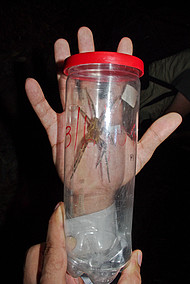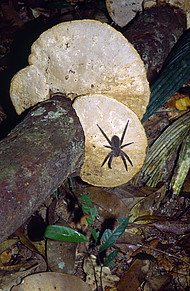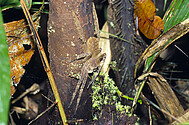Phoneutria - natural history
Spiders of the genus Phoneutria are nocturnal, with mainly cursorial habits. During the day they can be found in crevices, under rocks or fallen logs, or in bromeliads. Synantropic species like P. nigriventer are quite abundant in banana plantations, where they hide in the large dry leaves. They also enter in human dwellings, which provide dark and moist places (Vellard 1936, Bücherl 1968). At night the spiders can be found ambushing in vegetation and on the ground, depending on the species. As most other spiders they are generalist predators, feeding pretty much on every animal they can overcome - insects, other spiders, scorpions, scolopenders, frogs or lizards. Exceptions may be toxic animals – like poison dart frogs or, as observed by the author (C. Wesseloh) toxic moths e.g. of the family Zygaenidae. These are sometimes grasped, but then released.
In central Amazonia (Brazil) there are three sympatric species of Phoneutria: P. fera, P. reidyi and P. boliviensis. As expected in evolutionary theory the three species do not co-occur due to competition, but have their niches separated in the same habitat. While the two larger species (P. fera and P. reidyi) appear to be abundant in forests, the smaller species (P. boliviensis) seems to be restricted to inundation forests (in Amazonia; pers. comm. T. Gasnier). Also are P. fera and P. reidyi “ecologically separated”: while P. fera prefers the ground surface of the forest (leaf litter) as microhabitat, P. reidyi shows preference for lower vegetation, especially for acaulescent palms. Furthermore, they differ in their reproductive cycles. While reproduction of P. fera takes place throughout the year, P. reidyi shows seasonality in this aspect. Generally speaking P. reidy seems to be a habitat specialist while P. fera turns out to be a habitat generalist (Torrez-Sanchez & Gasnier 2010).
P. nigriventer, the “synantropic species” also shows seasonal reproduction. They usually mate during the dry season (April to July). During this time adult males are most likely be found in buildings, since they wander around more intensively, in search for females (Ramos et al. 1998, Herzig et al 2002, Martins & Bertani 2007).





